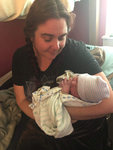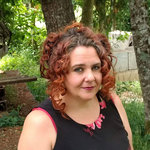

With no pun intended, Renee Terralumina believes she was born to be a midwife. When asked what she enjoys about the business of helping parents welcome babies into this world, she was matter of fact.
“Everything,” she said. “I almost feel like I was put together in my mother’s womb to do this.”
But for Terralumina, of Onalaska, who opened Quintessential Birth Services in April, the road to becoming a Licensed Midwife took some time. Growing up in a tiny town in Nevada, she had math and science teachers who recognized her aptitude and encouraged her to pursue a degree in science. At the age of 16, she was already a pre-med major. But while the science of medicine did and still does excite her, Terralumina said there was something missing for her.
“I discovered that Western medicine is really not my thing,” she said.
It was the different circumstances of her five children’s births that really led Terralumina to midwifery. A near debilitating needle phobia from childhood meant that she did not want medication during birth. With the birth of her first child in Nevada when she was 20, she was able to advocate for herself and have the birth experience she wanted, even though it was different than what the hospital staff was used to.
Two years later, living in Oklahoma and expecting her second child, she ended up choosing to have an unassisted home birth rather than submit to the requirements for a hospital birth that the doctors refused to bend on. She said the birth went well, but she was scared of what could go wrong and wished there had been someone who could have attended to her just to let her her intuition was correct that everything was alright. At the time, she did not even know midwives existed (and midwifery was illegal in both states at the time) but this experience would eventually lead her to the field.
“I swore to myself I would be that person some day so that no one had to make the choice between being alone or going to a hospital and submitting to something they do not agree with,” Terralumina said.
Several years later, Terralumina moved to Seattle where her third and fourth children were born with the assistance of the midwives who founded the Seattle Midwifery School. She said in both births she felt supported and heard by her providers. It was her ah-ha moment that showed her the career path her life experience had been leading her toward.
“I thought, wow, this is actually a legitimate path,” Terralumina said. “But I thought I couldn’t do it until my kids were grown.”
The family moved to Onalaska in about 2010 and opened Terralumina Gardens. The farm has grown produce for local farmers markets, this year providing goods to the Centralia and Toledo Farmers Markets. A back injury six years ago made Terralumina rethink whether her desire to become a midwife was a better option.
“My body could not keep up with farming,” Terralumina said. “I realized I had to have a career that I could use to support my kids.”
Terralumina said she is growing a lot of vegetables at Terralumina Gardens this year because she wants to support local consumers who are facing scarcity at grocery stores. But her overall goal for the property is to convert most of it into medicinal herbs.
Besides her own passion to become a midwife, Terralumina said she felt it was the right time to move into the field because she noticed a need for additional midwifery services in Lewis County. When she began her training, Laura Hamilton was the lone midwife supporting home births in Lewis, Pacific and Cowlitz counties. She completed as much of her training as possible through distance education with Midwives College of Utah while still farming but eventually had to leave her family to finish her training. Midwifery training takes three to five years, including attending 100 births before you can be licensed.
“It’s a massive amount of work,” Terralumina said.
One of her more memorable experiences during training was serving at Heritage Birth Center in Anchorage Alaska, which is located very close to the epicenter of the 2019 earthquake there. Terralumina delivered a baby at that center during that earthquake. But the end of her licensing process and attended births would bring her much closer to home. Though her practice is unique from Hamilton’s, Terralumina said she had the opportunity to work with the local midwife for a few births during the last phase of her licensing process. When Hamilton retired from her practice shortly before her death in April, Terralumina took over care of Hamilton’s final clients.
Quintessential Birth Services offers midwifery care for mothers in Lewis, Pacific and Cowlitz counties. Terralumina is in the process of arranging a work VISA for her friend Chris Arrowsmith, CPM. LM to come from Canada to be the second provider. Rebecca Larson is serving as Terralumina’s birth assistant.
The practice supports home, hospital or birth center births from prenatal care all the way through postpartum visits. Childbirth education classes are also offered, ranging from the traditional six-week course for couples, to a couple’s getaway to a support group for single mothers of babies up to 1-year-old. There are also doula services available. The practice accepts most insurance companies, as well as offering private pay options. Each offering, Terralumina explained, centers on helping each woman give birth on her own terms.
“My care is definitely client led,” Terralumina said. “I have the information. I will give them their options and they are the decider in their care. Even if what they want is not what I would have chosen, I support them. It’s their choice.”
A higher number of women have been choosing home birth during the COVID-19 pandemic. Higher demand on hospitals, a risk of infection for mothers and babies, having to give birth alone and even just difference in care standards because of a risk of infection are all reasons some women are looking at different options.
“The fear of going to a hospital at a time when your support people can’t be with you is big,” Terralumina said. “We’re seeing a lot of people who were on the fence before about home birth looking into it.”
Terralumina noted that birth is the only healthy, normal process of our physical lives that is treated as a pathology, even when the birth is deemed low risk. She said she believes that some birth complications can be caused by unnecessary interventions. She gave the example of differences in philosophy about pain management. She may use techniques such as aromatherapy and massage to help a mother deal with pain. In a hospital setting, epidurals are frequently used for pain management but Terralumina said this option requires the mother to be immobile, meaning it takes away her ability to move into different positions and potentially help with a difficult presentation, which could create an emergency.
“It’s a surrender of personal control. You’re not in a powerful place to feel you’re in control,” Terralumina said.
While she said she tends toward more natural births, Terralumina notes that she does not see Western Medicine as the enemy. She said a variety of choices open to expecting mothers is the best situation and she would like to be an instrument of healing between natural medicine and Western medicine. During her training, she worked for five years with preceptor Kara Neff in Yelm, who had forged very positive relationships with hospital staff.
“There’s a time and place for hospital birth, a time and place for hospital consults and everybody should be in their lane and that’s how everyone is served best,” Terralumina said.
In the future, Terralumina would eventually like to build a physical location for Quintessential Birth Services that includes a birthing suite near Castle Rock. She explained this would add another option for families who do not want a hospital birth but for whom home birth might also not be the best choice.